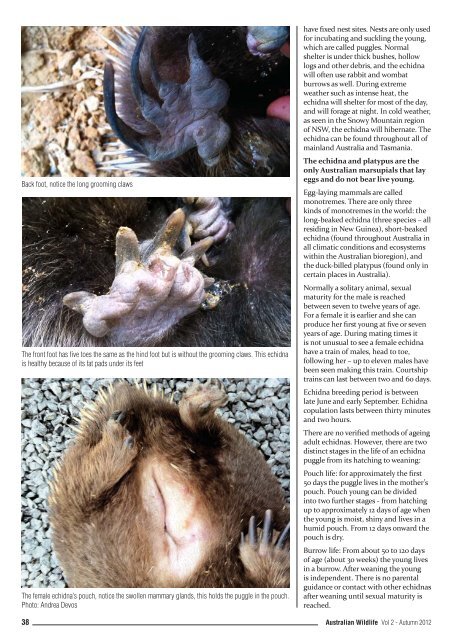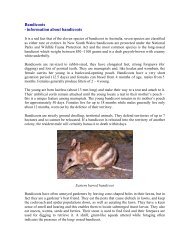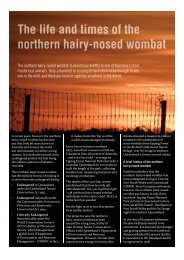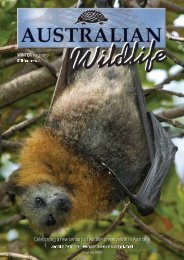Wildlife Preservation Autumn 2012.indd - Wildlife Protection Society ...
Wildlife Preservation Autumn 2012.indd - Wildlife Protection Society ...
Wildlife Preservation Autumn 2012.indd - Wildlife Protection Society ...
Create successful ePaper yourself
Turn your PDF publications into a flip-book with our unique Google optimized e-Paper software.
Back foot, notice the long grooming claws<br />
The front foot has five toes the same as the hind foot but is without the grooming claws. This echidna<br />
is healthy because of its fat pads under its feet<br />
The female echidna’s pouch, notice the swollen mammary glands, this holds the puggle in the pouch.<br />
Photo: Andrea Devos<br />
have xed nest sites. Nests are only used<br />
for incubating and suckling the young,<br />
which are called puggles. Normal<br />
shelter is under thick bushes, hollow<br />
logs and other debris, and the echidna<br />
will often use rabbit and wombat<br />
burrows as well. During extreme<br />
weather such as intense heat, the<br />
echidna will shelter for most of the day,<br />
and will forage at night. In cold weather,<br />
as seen in the Snowy Mountain region<br />
of NSW, the echidna will hibernate. The<br />
echidna can be found throughout all of<br />
mainland Australia and Tasmania.<br />
The echidna and platypus are the<br />
only Australian marsupials that lay<br />
eggs and do not bear live young.<br />
Egg-laying mammals are called<br />
monotremes. There are only three<br />
kinds of monotremes in the world: the<br />
long-beaked echidna (three species – all<br />
residing in New Guinea), short-beaked<br />
echidna (found throughout Australia in<br />
all climatic conditions and ecosystems<br />
within the Australian bioregion), and<br />
the duck-billed platypus (found only in<br />
certain places in Australia).<br />
Normally a solitary animal, sexual<br />
maturity for the male is reached<br />
between seven to twelve years of age.<br />
For a female it is earlier and she can<br />
produce her rst young at ve or seven<br />
years of age. During mating times it<br />
is not unusual to see a female echidna<br />
have a train of males, head to toe,<br />
following her – up to eleven males have<br />
been seen making this train. Courtship<br />
trains can last between two and 60 days.<br />
Echidna breeding period is between<br />
late June and early September. Echidna<br />
copulation lasts between thirty minutes<br />
and two hours.<br />
There are no veri ed methods of ageing<br />
adult echidnas. However, there are two<br />
distinct stages in the life of an echidna<br />
puggle from its hatching to weaning:<br />
Pouch life: for approximately the rst<br />
50 days the puggle lives in the mother’s<br />
pouch. Pouch young can be divided<br />
into two further stages - from hatching<br />
up to approximately 12 days of age when<br />
the young is moist, shiny and lives in a<br />
humid pouch. From 12 days onward the<br />
pouch is dry.<br />
Burrow life: From about 50 to 120 days<br />
of age (about 30 weeks) the young lives<br />
in a burrow. After weaning the young<br />
is independent. There is no parental<br />
guidance or contact with other echidnas<br />
after weaning until sexual maturity is<br />
reached.<br />
38 Australian <strong>Wildlife</strong> Vol 2 - <strong>Autumn</strong> 2012





